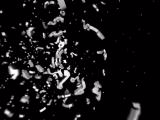
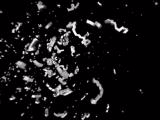
Completely Random ------- Minimum Force Path
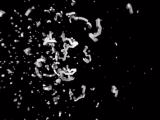
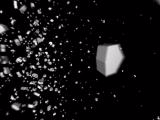
Minimum Distance Path ------- Minimum Normal Diff.
Introduction
This project was done for CS 348C -
Modeling in Computer Graphics. The initial aim of our project was
to create realistic looking explosions using computer graphics
modeling techniques. There are numerous reasons why one would want to
simulate explosions. The most important one seems to be for motion
picture visual effects. There are many instances in film making, such
as in sci-fi or action films, where an object needs to be exploded.
Even when most of the images of an object are computer modeled, most
film makers seem to rely on traditional pyrotechnics and a physical
model in order to achieve a realistic explosion. By implementing an
algorithm to do it in computer graphics, a lot of work and time would
be saved and, perhaps, more control over the final effect could be
achieved. Our goal was to try and create an algorithm that would
obtain reasonable results for a limited problem domain. What we
propose in this project is by no means a complete solution, but it is
a step in the right direction. Very little (computer graphics)
literature was available on the subject so we tried to base our
methods on heuristics.
Limiting the Problem
There are at least four distinct sections to an explosions which need to
be simulated to achieve a complete effect:
-The Fireball
These are all very complex problems in themselves. Since this was a
quarter project we decided to focus on only one of these parts, mainly
the problem of having an object submitted to an explosive force shatter
in a realistic way. Our objective was to shatter an arbitrary object or
objects given some forces acting upon it.
-The Flaming Debris
-The Smoke
-The Shattering of the Object
Input
Our first concern was to read in the objects using some generally available
modeling language. We chose to use
Virtual Reality Modeling Language (VRML)
because of the availability of a free reader library. Also a large number
of models existed for it. Our expectation was that we could convert
SOFTIMAGE 3D
scenes to VRML
(via Open Inventor)
without running into too many
difficulties. Unfortunately it turned out that things like camera
parameters were lost in the conversion.
Subdivision of Objects
In order to make the shattering of the objects look realistic we had to
subdivide each object into smaller patches or polygons. We chose to use
triangles which have some nice properties (e.g.: they are guaranteed to
be planar and all VRML objects can be subdivided into them) about them,
and are easy to deal with. Our algorithm would subdivide the object and
keep track of how the triangles were interconnected. This meant that at
each triangle we had a data structure containing information about the
adjacent triangles.
Physical Model
Our first intuition was to model the shattering of the object by using a
direct physical model where we would calculate the forces acting upon
all the triangles. We soon realized that this is a very expensive
process, since the force on every triangle is also dependent on the
force of every other triangle connected to it. Solving such a set of
equations is very expensive and time grows as the cube of the number of
triangles. So we quickly realized this was not the way to go.
Our "Model"
Our model consisted of three different parts: A particle system, a
collision detection system, and some cracking algorithms. Here is what
each of these does:
Particle System
We implemented a general particle system, where each particle would keep
track of its position and its rotational and translational velocities.
We used this particle system in order to move our shattered pieces
around the scene. What we would do is associate a particle with each
connected group of triangles and update them accordingly each time the
particle was updated. Each particle would move according to forces in
the scene and follow the F=ma equation. We could specify different
types of forces for a particular scene: Radial forces, Gravity,
Constant forces, Random forces, and any scale or combination of these.
Collision Detection
We also wanted the shattering objects in our scene to interact with each
other. For instance, if we put a floor beneath the object or walls around
the object, we would have liked the different pieces to bounce off as
expected. This turned out to be more complicated than expected and we
did not have time to implement a complete solution.
Cracking Algorithms
We initially cracked the surface of the objects by simply disconnecting
all the triangles and letting them fly off according to the force exerted
upon them. This looked decent but it was not enough to make the shattering
look realistic.
One common characteristic of explosions is that the individual pieces of flying debris have a wide variance of shape and size.
So we decided to implement different algorithms that would
traverse the surface and break it apart according to some method. All our
methods were based on probability. In each, the probability of breaking
a link was weighted by some heuristic that would determine how the surface
would crack. Here are the algorithms we implemented:
Completely Random: Here we did not weight the probabilities and
let the cracking be completely random.
Path of Minimum Force: Here we weighted the probabilities so that
it was more likely that we wouldn't break links that had less force exerted
on them.
Path of Minimum Normal difference: Here we weighted the probabilities
by the difference of the current normal and the next normal. In this way we
would try to pick the path that would keep us in the same general area.
Path of Minimum Distance: Here we weighted the probabilities by
using the geometric distance between the triangles' centers of mass. This also would keep us in
the same general area in order to keep "chunky" pieces.
Output
For the output of our program we used
RenderMan
Interface Bytestream (RIB)
files. This enabled us to use Larry Gritz's
Blue Moon Rendering Tools (BMRT)
or
Pixar's PhotoRealistic RenderMan
to render our scenes. Also, it gave
us a very flexible system with which to render our scene. For this project
we made and modified a couple of RenderMan shaders to produce glass and
other materials. We did not have time to use them to their full potential
because of time constraints.
In our animation we had a few extra features that are worth mentioning. We
first of all had the option of rendering thick primitives. Generally objects
were described as a surface, with no concept of thickness. This is enough
for solid objects, but once the object breaks apart we have to make it look
like the object had thickness in the first place. What was done here is that
we would extrude each triangle along its normal and create 4 more primitives (the back and sides of each triangle)
in order to make each piece look thick. Another feature we added was motion
blur. Since objects in our scene had a tendency to move very quickly because
of the extreme forces, we needed to make the transition between frames
as smooth as possible. We did this by keeping track of how the object moved
throughout the sequence and giving RenderMan the appropriate information
with which to blur.
Results
We created four animations to show the effect of the different cracking
algorithms. Each one shows a sphere being affected by a radial force offset
a little to the right of the sphere center. The animations are:
Completely Random algorithm,
Path of minimum force,
Path of minimum normal difference,
Path of minimum distance. Here are also four stills showing each results:




Minimum Distance Path ------- Minimum Normal Diff.
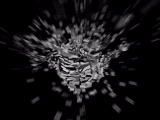
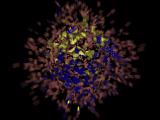
Finally, we have a few ideas for future work which we didn't have time to implement. The first is for the cracking algorithms. If we were to subdivide triangles more depending on the force exerted upon them, we believe we would get a more realistic effect, since objects tend to shatter more at points of extreme force. We could also try to come up with a more physically based model, by trying to only take into account interaction of forces between neighboring triangles, instead of all the triangles in the object. This would lead to much more solvable system of equations. Finally we could extend our models to have areas of strength, which determine how strong a certain area of an object is when a force is exerted on it. This would enable us to simulate the breaking of edges, for instance, more realisticly.